| KIT #: | 5316 |
| PRICE: | $85.00 SRP |
| DECALS: | One option |
| REVIEWER: | Scott Lyle |
| NOTES: | New tool kit |

| HISTORY |
The
end of World War One saw the imposition of the Treaty of
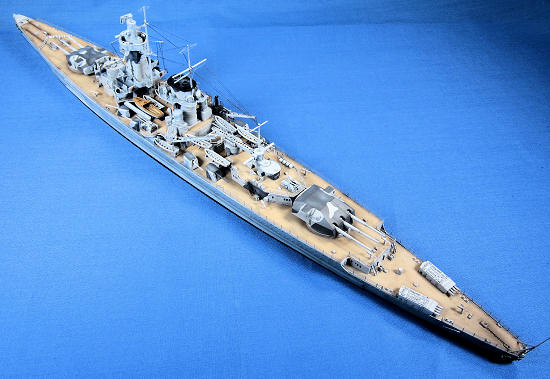 The class would consist of three ships; the
Deutschland
(renamed Lutzow
in 1939),
laid down in February 1929; the
Admiral Scheer,
laid down in June 1931; and the
Admiral Graf Spee,
laid down in October 1932.
They would each feature 28cm (11”) guns in two triple
turrets and would run 610’ in overall length.
While
The class would consist of three ships; the
Deutschland
(renamed Lutzow
in 1939),
laid down in February 1929; the
Admiral Scheer,
laid down in June 1931; and the
Admiral Graf Spee,
laid down in October 1932.
They would each feature 28cm (11”) guns in two triple
turrets and would run 610’ in overall length.
While
Even though the Reichsmarine was not obeying the Treaty
to a tee, the ships were designed using innovative weight-saving techniques.
Over 90% of the hulls were constructed using welding
instead of traditional riveting, the weight savings from which was used to
increase armor protection.
The ships were powered by lightweight, nine-cylinder
diesel engines that allowed the ships to reach speeds close to 30 knots.
Enough fuel oil was carried for the ships to have ranges
around 10,000 nautical miles, allowing them great endurance in their intended
role of commerce raiding.
The
Graf Spee was launched in June 1934 and
commissioned in January 1936.
After three months of trials, she officially became part
of the fleet.
She saw three tours during the Spanish Civil War, and also
participated in diplomatic missions.
When war broke out, she was soon in action.
By the end of September 1939 she was off the coast of
All of this work attracted a great deal of attention
from the British, who had battle groups frantically searching for her.
In mid-December the cruisers
HMS 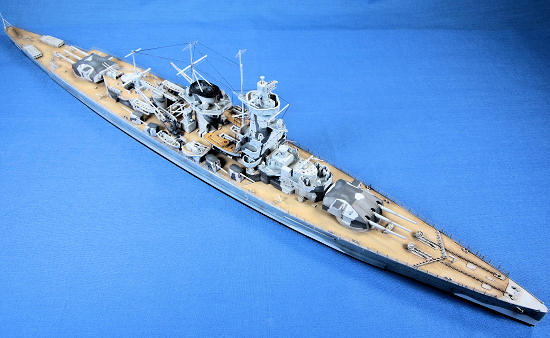 st
of
st
of
Tallying her damage, she had suffered some 19 hits from the British cruisers. While there was no serious structural damage, her desalination plants, kitchens, and oil purification plant had been destroyed. Her ammunition was very low, and a large gash in her bow would make the trip back home in the North Atlantic dangerous. She also suffered almost one hundred dead and wounded. With international law specifying that a ship could only stay in a neutral port for 72 hours, the Graf Spee’s charismatic commander, Kapitan zur See Hans Langsdorff, had two choices – stay in port and face internment, or head out to sea to face oncoming British forces. Unwilling to risk the lives of his 1,200 crewmembers, he elected to scuttle the ship to prevent her from falling into British hands. On December 17, with most of her crew ashore, Langsdorff took the ship out away from the harbor and stopped the engines. An Argentinian tug took the remainder of the crew off the ship and at 2055 charges placed throughout the abandoned ship went off. She sank in 36 feet of water, and her wreckage is still there today. Three days later, Kapitan Langsdorff committed suicide.
| THE KIT |
 Despite
its brief life the Graf Spee has always been a popular subject for modelers.
Currently both Academy and Trumpeter issue fine models
of the ship in 1/350th scale.
Fresh off my very positive experience building their
1/48 Wellington kit, I opted for the Trumpeter kit.
I added photo etch set #53045 from Eduard and a brass
barrels set from Master Models (#35044) to the build, though not without
trepidation.
It has been a long time (about 30 years to be exact) since I
built a 1/350 scale model of a surface ship (the Tamiya 1/350 USS New Jersey),
and one look at the rather large Eduard photo etch fret told me I was in for a
lot of bending and work with tweezers.
Nonetheless, I was excited to start this new project, so
off I went.
Despite
its brief life the Graf Spee has always been a popular subject for modelers.
Currently both Academy and Trumpeter issue fine models
of the ship in 1/350th scale.
Fresh off my very positive experience building their
1/48 Wellington kit, I opted for the Trumpeter kit.
I added photo etch set #53045 from Eduard and a brass
barrels set from Master Models (#35044) to the build, though not without
trepidation.
It has been a long time (about 30 years to be exact) since I
built a 1/350 scale model of a surface ship (the Tamiya 1/350 USS New Jersey),
and one look at the rather large Eduard photo etch fret told me I was in for a
lot of bending and work with tweezers.
Nonetheless, I was excited to start this new project, so
off I went.
| CONSTRUCTION |
Studying the instructions for both the
kit and the Eduard photo etch set revealed a very clever move by Eduard – they
designed the steps in their instructions to match those of Trumpeter.
So rather than have to hunt through the Eduard
instructions to find the photo etch parts to add to the part you’re working on,
you simply proceed with the Trumpeter and Eduard instructions side by side,
building the plastic and metal pieces of each subassembly together as you go.
This greatly sped up the construction process and within
a few nights I had the various gun turrets, cranes, and torpedo launchers
completed.
I soon began looking ahead to the various superstructure steps
when it occurred to me - how am I going to paint this thing?
Or more specifically, how am I going to build all of
these overlapping decks and superstructure parts and still be able to paint
them?
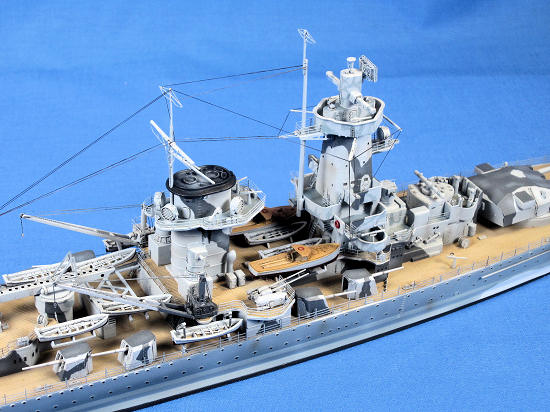 Complicating things was that the Graf Spee wore a
camouflage pattern at the end of its life.
Consulting several online sources, the ship’s hull was
KM 02 Dunkelgrau 51 while the superstructure was KM 01 Hellgrau.
The steel decking of the superstructure was KM 02, and a
camouflage pattern of KM 02 and KM 06 Dunkelgrau 2 was applied by the crew to
the superstructure shortly before its final battle.
Of course this is a surface ship with a wood deck so
between all of that you have to paint much of the decking a wood color.
Complicating things was that the Graf Spee wore a
camouflage pattern at the end of its life.
Consulting several online sources, the ship’s hull was
KM 02 Dunkelgrau 51 while the superstructure was KM 01 Hellgrau.
The steel decking of the superstructure was KM 02, and a
camouflage pattern of KM 02 and KM 06 Dunkelgrau 2 was applied by the crew to
the superstructure shortly before its final battle.
Of course this is a surface ship with a wood deck so
between all of that you have to paint much of the decking a wood color.
So unlike building an aircraft or a tank model where you
can largely assemble the whole thing and then paint it, with a ship you have to
so some assembly, then some painting, then more assembly, followed by more
painting, and so on and so forth.
Eventually I decided to start building the model from
the hull up and from the center of the ship out towards the ends, painting and
assembling things as I went.
Intending to build the waterline version of the ship, I
attached the anchors and PE railings to the hull and then headed to the spray
booth for my first painting session.
I applied a light coat of Tamiya’s Spray Primer to the
hull and deck parts first.
I then preshaded the hull with Tamiya XF-69 NATO Black,
and then sprayed Tamiya XF-2 Flat White onto the bow areas to replicate the
ship’s so-called false bow wave.
I masked those off with Silly Putty and sprayed a light
coat of Testors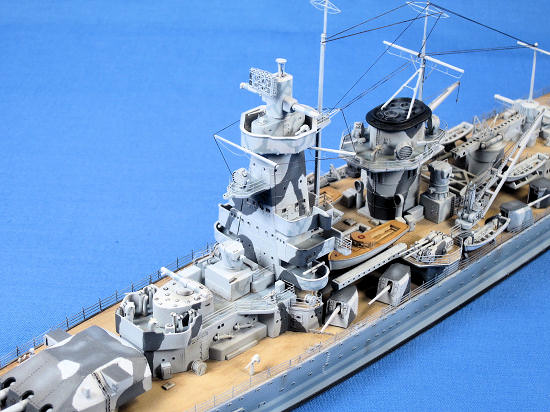 Medium Gray FS 35237 (to replicate the KM 02) onto the hull and railings.
This was lightened with some white and some random
splotches were sprayed on to add fading and variation to the hull.
The deck parts were pre-shaded with Tamiya XF-64 Red
Brown and then some Tamiya XF-78 Wooden Deck Tan was sprayed lightly over that.
Once the deck parts were dry I picked out the gray parts
with a brush using Testors Light Ghost Gray FS 36375 to replicate the KM 01
Hellgrau color.
I then glued the main decks to the hull, and in the process one
little annoyance popped up.
The main deck is split in two parts, and the seam is not
hidden by superstructure parts mounted over it.
I ended up gluing the two main deck parts together by
using a piece of plastic card under the seam as a backing plate of sorts.
The seam was then filled with putty and the deck timber
lines were rescribed.
Medium Gray FS 35237 (to replicate the KM 02) onto the hull and railings.
This was lightened with some white and some random
splotches were sprayed on to add fading and variation to the hull.
The deck parts were pre-shaded with Tamiya XF-64 Red
Brown and then some Tamiya XF-78 Wooden Deck Tan was sprayed lightly over that.
Once the deck parts were dry I picked out the gray parts
with a brush using Testors Light Ghost Gray FS 36375 to replicate the KM 01
Hellgrau color.
I then glued the main decks to the hull, and in the process one
little annoyance popped up.
The main deck is split in two parts, and the seam is not
hidden by superstructure parts mounted over it.
I ended up gluing the two main deck parts together by
using a piece of plastic card under the seam as a backing plate of sorts.
The seam was then filled with putty and the deck timber
lines were rescribed.
With the base coats of color now in place, I began
building up the superstructure assemblies.
In general I assembled the larger parts (e.g. decks and
platforms) first, then added the delicate details (e.g. PE parts and small guns)
second, painting with both brush and airbrush as I went.
There are several good websites that show the camouflage
patterns on the superstructures, but of course they can’t show the pattern on
all of the surfaces, so you have to use some artistic license.
Before long I had the model largely complete and
painted, but I decided to leave off the gun turrets, cranes, and lifeboats until
after I applied some weathering.
| COLORS & MARKINGS |
I
confess I have no prior knowledge of how to weather a ship model.
I’ve read a lot about weathering aircraft and tanks, but
not ships.
I figured washes and pastels would come into play, but I didn’t
want to just charge ahead and slather a wash on
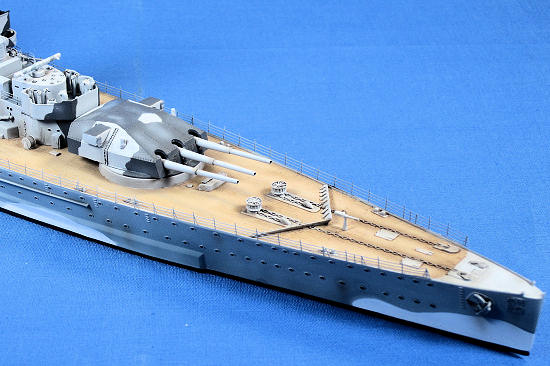 everything
and come out with a brown-tinted ship.
But of course that’s basically what I did.
everything
and come out with a brown-tinted ship.
But of course that’s basically what I did.
I first applied a wash to the wooden decks using Mig
Productions’ “Brown Wash”, removing the excess with a brush soaked in thinner.
I then applied a “pin wash” of Mig Productions’ “Dark
Wash” to all of the small detail items like anchor chains, turret details,
superstructure seams, etc.
When that was dry I sprayed a very thin mix of 50/50
Tamiya Black/Red Brown onto the various seams and crevices of the model to
provide some post-shading and streaking effects.
I tried to keep it subtle because at this scale, it’s an
effect that is easily overdone.
Back at the workbench, it was time to rig the model.
I used small dabs of CA glue to attach EZ Line to the
various masts.
With that finished I next glued all of the turrets, cranes, and
lifeboats in place, a gratifying step that really made it look like a warship!
The final step was to brush-paint over any areas that were glossy due to the CA glue. I did this using Vallejo’s Matt finish, and then the model was done.
| CONCLUSIONS |
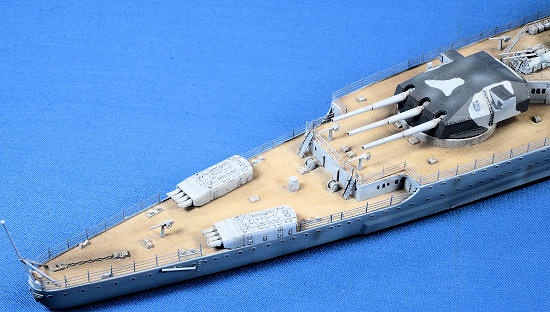 There’s
something very cool about model ships, especially at a good-sized scale like
1/350.
With all of those little decks and ladders and passageways leading in
different directions, it appeals to the kid in me who still wants to go outside
and build some Rube Goldberg-esque tree house.
There’s
something very cool about model ships, especially at a good-sized scale like
1/350.
With all of those little decks and ladders and passageways leading in
different directions, it appeals to the kid in me who still wants to go outside
and build some Rube Goldberg-esque tree house.
Trumpeter’s Graf Spee was a fun and pleasant build that
anyone could enjoy.
It took me about two months to finish, working at my
usual pace.
If one didn’t add any photo etch that time would drop
substantially.
I experienced no fit issues at all and had just one minor
complaint; that being the two piece main deck.
The variety of ship kits available now in 1/350 scale is
mind boggling, especially when compared to the mid-80s when I built the Tamiya
New Jersey.
I’m looking forward to building even more and bigger ships in
this scale!
| REFERENCES |
-
Osprey Publications, New Vanguard #75,
“German Pocket Battleships 1939-45”
-
Squadron/Signal Publications, Warships in Action #23,
“German Battleships of World
War Two in Action”
May 2012
If you would like your product reviewed fairly and fairly quickly, please contact the editor or see other details in the Note to Contributors.